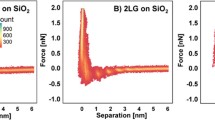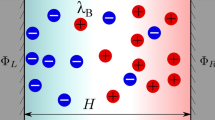Abstract
We combine electronic density functional theory for the screening properties of graphite with a mean-field theory of the double layer in ionic liquids to reveal what underpins the morphology of the voltage dependence of electrical capacitance of a flat graphite/ionic liquids interface.




Similar content being viewed by others
Notes
There are currently hot discussions about the degree of ionic dissociation in RTILs., including the extreme point of view that most of the ions in RTILs are bound in ion pairs, giving rise to a dielectric constant of about 10, with only a small number of virtually free moving ions, bringing the properties of RTILs close to those of dilute ionic solutions [14]. However, this point of view is at odds with a number of experimental facts and computer simulations[15]. Therefore, before further tests of this hypothesis have been performed, we will not explore the opportunity of adopting much lower effective concentrations of free ions, which would bring \(C_{0}\) to much more reasonable, smaller values. Small values of effective concentrations of ions, would cause small values of \(\gamma \), which would make all the capacitance curves U-shaped; moreover the total capacitance of the interface would be entirely dominated by the double layer capacitance in RTILs, and there would be no effect of the substrate.
References
Kornyshev A (2007) J Phys Chem B 111:5545–5557
Fedorov MV, Kornyshev AA (2008) Electrochim Acta 53:6835–6840
Bazant MZ, Storey BD, Kornyshev AA (2011) Phys Rev Lett 106(046102):1–4
Georgi N, Kornyshev AA, Fedorov MV (2010) J Electroanal Chem 649:261–267
Fedorov MV, Georgi N, Kornyshev AA (2010) Electrochem Commun 12:296–299
Fedorov MV, Kornyshev AA (in press) Chem Rev
Merlet C, Rotenberg B, Madden PA, Salanne M (2013) Phys. Chem Chem Phys 15:15781–15792
Luque NB, Schmickler W (2012) Electrochim Acta 71:82–85
Gerischer H (1985) J Phys Chem 89:4249–4251
Gerischer H, McIntyre HR, Scherson D, Storck W (1987) J Phys Chem 91:1930–1935
Randin JP, Yeager E (1972) Electroanal Chem 36:257–276
Islam M, Alam M, Ohsaka T (2008) J Phys Chem C 112:16568–16574
Locket V, Sedev R, Ralston J, Horne M, Rodopoulos T (2008) J Phys Chem C 112:7486–7495
Gebbie MA, Valtiner M, Banquy X, Fox ET, Henderson WA, Israelachvili JN (2013) PNAS 110:9674–9679
Perkin S, Compton R, Slanne M, Madden P (2013) PNAS. doi:10.1073/pnas.1314188110
Daikhin LI, Kornyshev AA, Urbakh M (1996) Phys Rev E 53:6192–6199
Hu Z, Vatamanu J, Borodin O, Bedrov D (2013) PCCP 15:14234–14247
Hu Z, Vatamanu J, Borodin O, Bedrov D (2012) J Phys Chem C 116:7940–7951
Acknowledgments
AAK is thankful to EPSRC for grant EP/H004319/1. WS and NBL acknowledge support from the DFG under FOR 1376, and thank the Baden- Württemberg grid for a generous grant of computer time.
Author information
Authors and Affiliations
Corresponding authors
Rights and permissions
About this article
Cite this article
Kornyshev, A.A., Luque, N.B. & Schmickler, W. Differential capacitance of ionic liquid interface with graphite: the story of two double layers. J Solid State Electrochem 18, 1345–1349 (2014). https://doi.org/10.1007/s10008-013-2316-8
Received:
Revised:
Accepted:
Published:
Issue Date:
DOI: https://doi.org/10.1007/s10008-013-2316-8




